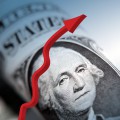Financial leaders voice concern over direction of global economy.
America’s financial services industry plays a strong role in the country’s economy, contributing nearly a tenth of the gross domestic product annually. As it does, the industry also accounts for a sizable chunk of corporate profits.
Although this area of the economy has recovered rather nicely since the Great Recession, some say finance’s continued dominance of the economy is potentially dangerous.
Finance’s Continued Growth
Finance’s slice of the gross domestic product (GDP) peaked in the 2000s at more than 8%, according to Bloomberg. Even with the Great Recession taking its toll on the economy and the industries that drive it, the U.S. Commerce Department estimated in 2014 that finance and insurance combined represented about 7.2% or $1.26 trillion of the U.S. GDP. In 2011, the U.S. exported $92.5 billion in financial services, the government reported on its SelectUSA website.
While profitability and industry often go hand-in-hand, that’s not the case with finance. Even in the 1960s, when finance accounted for less than 5% of the U.S. economy, it still made up 10% to 15% of corporate profits, Bloomberg noted. At present, two subsectors of the industry are largely responsible for finance’s continued growth and dominance – asset-management fees and lending to households.
You Might Also Enjoy: Finance 101: Teaching Kids about Money
Asset-management fees are the small costs middlemen pass along to all sorts of players in the financial industry as money and assets are shuffled around. These fees generally show up as percentage charges based on the size of the assets being managed. Since the fees are relatively small – 1% to 2% a year – some speculate this part of the industry has continued to grow simply because individuals only face small charges directly and fail to notice them. These fees, however, add up significantly.
Household credit also remains a driving force behind finance’s continued growth in the country. Household credit is estimated to have climbed from 48% of the GDP in the 1980s to about 99% in 2007, before the crash. Despite the recession, lending has remained quite profitable, perhaps due to economies of scale. Reliance on this segment of the financial industry to drive the economy can have disastrous results, as was witnessed in 2008.
The Potential Pitfalls
While the finance industry has managed to drive and dominate the American economy for years, dangers do exist with a continued reliance upon it. Aside from the pitfalls associated with lending to households, the direction the global economy will take over the next few years is largely an unknown factor. The old model that once drove the global economy is no longer as viable as it once was. That model called for the emerging world to export commodities and manufactured goods to richer economies. Demand from richer countries, however, has leveled off in recent years. This potential danger has presented just as some say central banks have nearly run out of tools to help the developed world quickly climb out of another recession should one develop. The two factors could combine to make continued reliance on the finance industry to drive the domestic economy a precarious bet.






